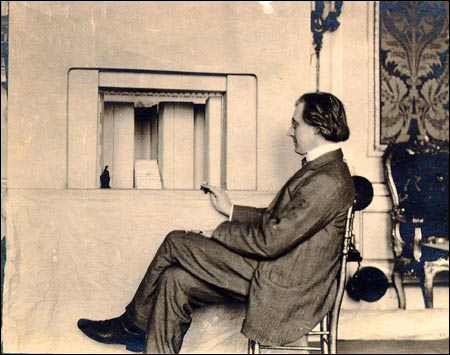Exhibition documents life of influential theatrical designer:
Edward Gordon Craig was known for using nonrealistic, symbolist design rather than sentimentality

Edward Gordon Craig (1872-1966) was perhaps the most influential theatrical designer in the first decades of the 20th century, and was known for using nonrealistic, symbolist design rather than sentimentality in his creations. A master at the art of woodcut engravings, a publisher, editor, book illustrator, and essayist, Craig’s passions covered many art forms, but all were driven by his devotion to the theater and his conviction that he alone envisioned the grand design that would renew the life of the theater. A new exhibition, “Edward Gordon Craig and the Art of the Theatre,” explores Craig’s life and work and is on display at the Harvard Theatre Collection, Pusey Library, through May 30.
The son of the famous English actress Ellen Terry, Craig grew up in the theatre as an actor and creator of sets and costumes. He used abstract scenic elements and lighting to create striking, dramatic effects from simple objects, in contrast to the realistic backdrops common to the theater of his day. He employed movable elements and screens that could be placed on the stage in a variety of configurations. The exhibition includes an elaborate set of fretted wooden model screens that Craig cut to instruct students attending his short-lived School for the Art of the Theatre, as well as a model stage with modular blocks to demonstrate the versatility of his stage design concepts.
The Harvard Theatre Collection is open Monday through Friday from 9 a.m. to 4:45 p.m. For more information, call the Harvard Theatre Collection at (617) 495-2445.
Copies of “The Mask,” a journal Craig published to promote his own ideas about theater design, are featured. The managing editor for “The Mask,” Dorothy Nevile Lees, preserved editorial and publication records, as well as her 60-year correspondence with Craig, all of which are shown for the first time in this exhibition. These documents reveal the intricacy of their personal and working relationship, Craig’s compelling character, and the details of his artistic work.
Throughout Craig’s career he returned to Shakespeare’s “Macbeth” and “Hamlet” again and again, reworking staging ideas and the meaning of the text. The Harvard Theatre Collection documents his fixation with these texts and includes model screens and scenic elements, woodcut engravings, and documents that relate to several productions and publications of “Hamlet” by Craig. In addition, a notebook on “Macbeth,” which Craig annotated and illustrated over a period of 65 years, incorporates drawings, diagrams, stage directions, and comments about his own evolving interpretations of the play.




